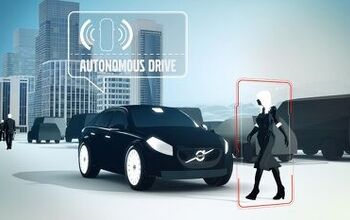Do Driver Aids Make Us Worse Drivers?
Former TVR owner Peter Wheeler used to explain the lack of airbags in his firm’s high-powered sportscars by arguing drivers would be safer if he installed a metal spike in the middle of each steering wheel. That was back in the late 1990s and early 2000s… since then, the rise of adaptive cruise control, “attention assist” systems, collision-sensing brake pre-loading and more have only made his critique all the more provocative. And, according to research cited in a Wired Magazine report, Wheeler’s philosophy seems to have a strong basis in science.
“The point the automakers are making, which is true, is that they go to extreme lengths to make these systems work and extremely reliable,” [Stanford University’s Clifford] Nass said. “The reliability on these systems is very high. If you have automatic cruise control, it’s not extremely often you have to jump into the fray.”
Therein lies the problem. We come to count on our cars to keep us out of trouble, even in situations where the technology isn’t designed to.
“Road hazards other than the car in front of you are so rare, especially on the highway where these adaptive cruise control systems would be in play, that they would, over time, encourage a complacency that undermines safety,” said Erik Blaser, a psychology professor at the University of Massachusetts, Boston, who studies vision and perception. “You stop paying attention to the driving.”
Though these “semiautonomous” systems are sold as safety equipment, researchers argue that they create a sense of reliance that actually makes drivers less safe (unlike “secret” safety systems like stability control and ABS, which operate consistently without the driver’s knowledge). And, somewhat counterintuitively, these researchers argue that the rise of semiautonomous driver aids actually increases the need for life-long driver eduation.
The report notes:
“The functionality of the technology is very good at this point, but how do you teach people how to use it appropriately?” MIT AgeLab and New England University Transportation Center researcher Bryan]Reimer said. “Reading the owner’s manual is not going to provide the information that you need.”
Instead, he suggests ongoing, lifetime driver training and an end to the American tradition of driver’s education only for new drivers. Auto dealerships should spend more time working with customers to fully explain the limits of automotive safety technology before letting them drive home. Looking further ahead of the curve, cars could one day actively detect drivers’ states — whether they’re tired or distracted, for instance — and allow the use of semiautonomous safety technologies when appropriate.
The limitations of active safety systems must be second nature to drivers, said Nass. Drivers must know what the technology can and can’t do so they don’t rely upon it in situations where it won’t work.
“It’s always a problem with partially autonomous systems,” he said. “You’ll always have the issue of remembering what it does and what it doesn’t do, and in real time we don’t want people pondering that.”
More by Edward Niedermeyer
Latest Car Reviews
Read moreLatest Product Reviews
Read moreRecent Comments
- Calrson Fan Jeff - Agree with what you said. I think currently an EV pick-up could work in a commercial/fleet application. As someone on this site stated, w/current tech. battery vehicles just do not scale well. EBFlex - No one wanted to hate the Cyber Truck more than me but I can't ignore all the new technology and innovative thinking that went into it. There is a lot I like about it. GM, Ford & Ram should incorporate some it's design cues into their ICE trucks.
- Michael S6 Very confusing if the move is permanent or temporary.
- Jrhurren Worked in Detroit 18 years, live 20 minutes away. Ren Cen is a gem, but a very terrible design inside. I’m surprised GM stuck it out as long as they did there.
- Carson D I thought that this was going to be a comparison of BFGoodrich's different truck tires.
- Tassos Jong-iL North Korea is saving pokemon cards and amibos to buy GM in 10 years, we hope.

































Comments
Join the conversation
I see I have posted too much already in this thread but one final comment if I may....it seems clear to me that skill and knowledge must play SOME part in staying safe so training simply CANNOT be totally useless....BUT....I think it is absolutely clear that it is driver ATTITUDE that is the biggest key in safety. If we all drove within our own capabilities (we ALL over-estimate our abilities) and within road and traffic conditions then MOST crashes (they are NOT accidents) could be avoided. Sadly, many, many people don't do so, thus we continue to have carnage on the roads.
Locking the brakes also works better than ABS on most gravel road conditions. That's why some "rugged" vehicles come with hill descent features, and/or an ABS setting for gravel. Keeping your foot in it will overcome the Traction Control's use of ABS and throttle backoff in a couple of seconds. They're engineered this way to avoid brake damage, for one thing. The consequence is wheelspin, wanted or not. The delay before deactivation can be a nuisance, though. Of course, many vehicles have a deactivation switch of some sort. An experiment this winter proved that our suv could climb a steep hill in deep, heavy damp untracked snow best in 4-high/AWD mode, rather than 4-high/locked or 4-low/locked. TC and SC are active in 4-high/AWD. It couldn't make it up the hill in locked mode, coming to a halt with spinning tires and then sliding sidways. In normal driving mode (4-high/AWD), it seemed to think about it and clawed its way up. I was very surprised, but couldn't argue with how clear the difference was. Some suggested SC activation is proof of incompetence. It could activate as you try to escape an emergency caused by someone else.